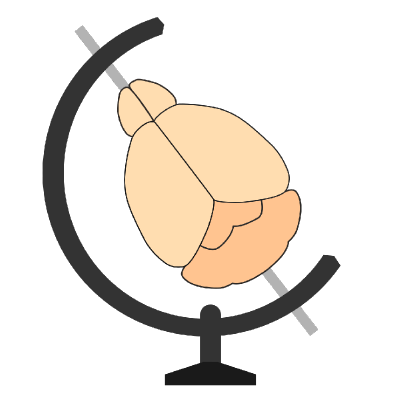Videos, animations and exporting to html#
A key goal for brainrender was to facilitate the dissemination of neuroanatomical data. To do so, creating
spectacular renderings is not enough, you need to have a way to export them into a format that you can easily share.
For this reason we’ve put a lot of effort into allowing you to do just that by creating screenshots, animated videos
and interactive online visualizations with your renderings.
You can find examples about how to do all of this at the GitHub repository.
Screenshots#
The Scene class has a screenshot method that allows you to save a .png, .jpg, .svg, .pdf, or .eps image showing the current view of the
rendering. By default, the screenshots are saved in the current directory, but you can use screenshots_folder to
pass a path to the folder where you want them to be saved when you’re creating an instance of Scene.
Note
When saving a .svg or .eps file the output will be compressed as a .gz and will need to be extracted
before it can be viewed.
You can take a screenshot while viewing and interacting with a rendered scene by pressing the s key in your keyboard.
Using Scene.screenshot however gives you the freedom to specify a name for the image file to be saved.
By default brainrender is set up to ignore the background when saving the screenshots. That means that you will have
all of your rendered objects in your image, but the background will be transparent. If you want to include the
background in your image, include these two lines before creating the screenshot:
import brainrender
brainrender.SCREENSHOT_TRANSPARENT_BACKGROUND = False
Hint
You can also quickly take a screenshot by pressing the “s” key on your keyboard while interacting with the scene!
Videos#
The beauty of creating 3d renderings is that you can look at your data from multiple points of view. A 2d picture can’t convey the same information, but a video showing the brain moving across frames may.
For this reason brainrender supports the creating videos where at each frame it shows the current view of the scene
and in-between frames it lets you move the scene around.
The easiest way to create a video is with the VideoMaker class. This takes a populate scene as argument and allows
you to create a video by specifying how the camera should move at each frame in the video. The basic VideoMaker class
only allows for rotations in the three principal directions, however you can use a custom function to specify what
should happen at each frame.
If you need to make more sophisticated animation (e.g. with actors being added, removed or edited in the video), you
might prefer to use the Animation class. This allows you to specify the video’s content by defining a few keyframes.
At each keyframe you can specify a few parameters (e.g. camera position) and a function to be called when that point
of the video is reached: you can then have your function perform the actions that you need (e.g. add a new actor). The
video is then created by interpolating the parameter across keyframes and calling the specified functions when
necessary.
Exporting to html#
Videos are an improvement over screenshots in that they let the viewer see the scene from multiple points of view.
Ideally though you would need a way to let the viewer explore the scene at their own will, moving the camera around,
zooming etc., the same way you do when you create your renderings. brainrender also lets you
export your scene to an .html file which you can send to your colleagues (so that they can open it in their web
browser) or embed in a website such as this one.
Caution
Warning: for large and complex scenes the resulting html file might be fairly large (>100MB) and loading the interactive scene in your web browser might take a few minutes.
Exporting to html is simple, all you need to do is create a Scene, add elements to it and once you’re happy
with it use the export method of Scene to create the .html. e.g.:
from pathlib import Path
from myterial import orange
from rich import print
from brainrender import Scene
print(f"[{orange}]Running example: {Path(__file__).name}")
# Create a brainrender scene
scene = Scene(title="brainrender web export")
# Add brain regions
scene.add_brain_region("MOs", "CA1", alpha=0.2, color="green")
# Render!
scene.render()
# Export to web
scene.export("brain_regions.html")
Important
Not all of brainrender's features can be included into your web export (because of limitations with the
k3d package. For instance the appearance of your exported scene might be different from the one you
saw in brainrender.
